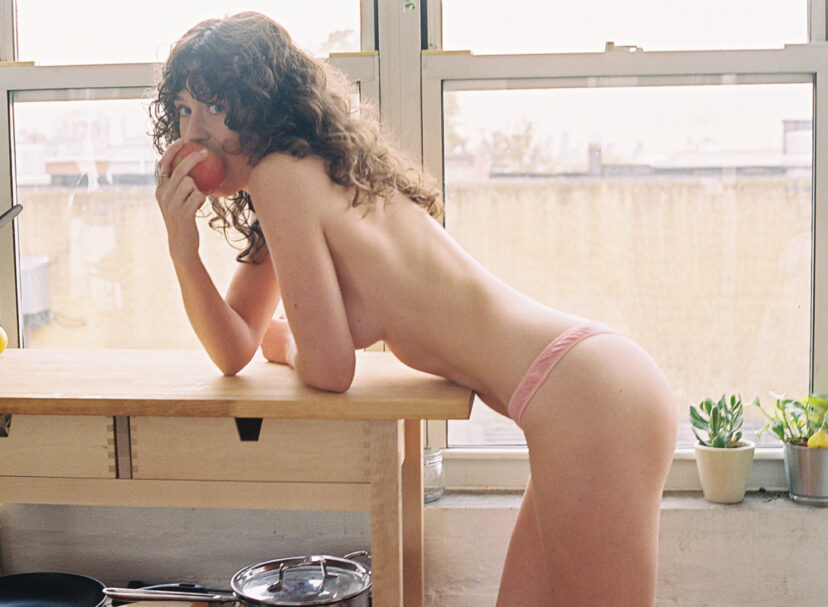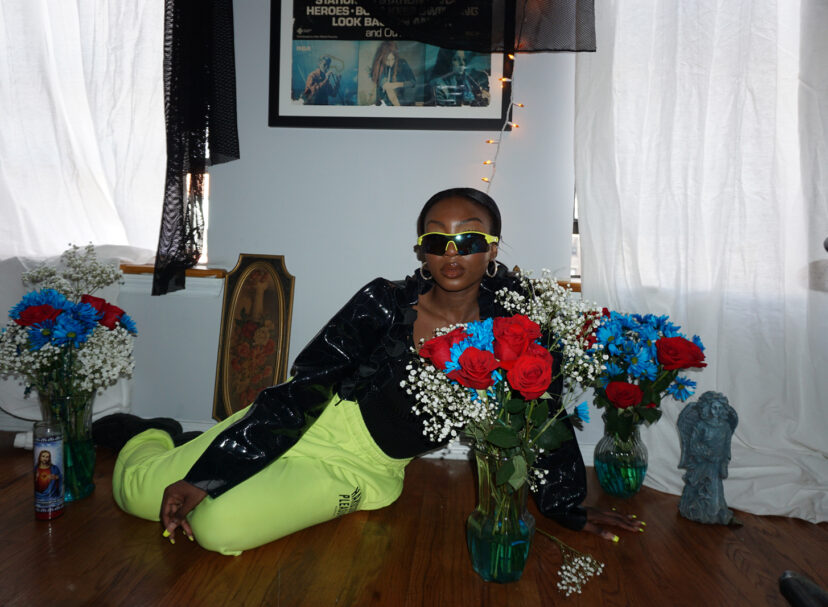Text: Alec Coiro
Images Courtesy of Bruce
Our feature on design duo Daphne Gutierrez and Nicole Noselli is the first installment of a two-part series on the team. Gutierrez and Noselli finishing preparations for the launch of their new label Third Story, which we’ll follow up on as soon as it’s done percolating. The article you see before you now look back at their previous label Bruce and continues our ongoing series on art, fashion, and New York City at the turn of the 21st Century. So it was with my fashion historian chapeaux that I set out to visit the Canal Street studio they’ve occupied since 2001 (in the same building where we visited Correll Correll a few years ago).

Gutierrez and Noselli started out as schoolmates in the design program at Parsons in the 1990s, and in those halcyon ‘90s days, the horizon spreading out before design students were different and narrower than it is today. The early 90’s assault on major labels in the music industry had yet to reach the shores of the fashion industry. Noselli recalls that “New York was different. The fashion industry was very different. When we started the line, it was all about large companies; it was about Seventh Avenue: Donna Karan, Marc Jacobs, Ralph Lauren.” Gutierrez jumps in (the pair seem able to both design and think in tandem), “It was always about big names.” Noselli continues, “You got out of school, and what do you do? You go work for a big name.”
And that is what they both did: they got the sort of jobs a BFA would get you in the ‘90s fashion industry. And yet a corporate fashion job on Seventh Avenue fell short of the aspirations and taste of the young designers. It’s was not that they were embittered outsiders; they’re both talented, competent designers who got work right out of Parsons; it was more that, as Daphne puts it, “It was like this is a job, you’re getting a paycheck and you’re designing for women who are possibly your mother’s age.” She contrasts that with the experience of being “in art school and experimenting, and by the time you graduate you’re thinking is there something more than this.”
They started Bruce as a way to keep the promise of the creative young design student alive. Perhaps the impetus came from the same place as that 90s impulse to launch an independent record label over frustration with mainstream music. After all, as Gutierrez points out, “We are the MTV generation. The very first MTV generation. Before it was 24 hours.” But before they launched Bruce there was not the same precedent for starting a small label that there is today. The notion that small labels could be important took shape as Bruce grew. Gutierrez recalls, “It was a different culture. At the time of our generation, the idea of the downtown designer was just coming up.” Noselli continues, “There was a stylist Camilla Nickerson who worked at Vogue and she was the one I think who got Anna Wintour to visit all the young designers when they would never do that. But now the younger designers are part of the fashion culture and people look at them like they’re doing something that’s valid. Back then it took a lot. It took longer to get your foot in the door.”
This is not to say that Noselli and Gutierrez were working in a vacuum. Gutierrez remembers being inspired by her peers, “There was Susan Cianciolo and there was Bernadette Corporation and they were doing shows back then. It was a fun time. It seemed possible.” In Noselli recollection, however, the impetus was perhaps not quite the same. “I look at it a little differently. When we were in school we looked at certain designers. And the designers that I liked were European designers or in New York, there was Isabel Toledo, who wasn’t part of the whole big job system. I didn’t see myself fitting in at a company like Donna Karan because I couldn’t relate to it. I could relate to all the small designers that I saw in Europe and they were doing things small. With groups of friends helping them get their lines together.”





We are the MTV generation. The very first MTV generation before it was 24 hours.







In the case of Bruce, the group of friends at its core was — of course — Noselli and Gutierrez. It’s a team that has stuck together for going on three decades, a fact that becomes increasingly impressive the longer it’s true. But the question of how they work together so seamlessly seems slightly befuddling to designers because their working relationship comes so naturally to them. After some light grilling on my part, Gutierrez postulates that the key is ultimately a shared willingness to put in the hours, “You have to have a similar work ethic. If one person’s doing one thing and not working, you’d be like ‘hmmmmm.’” Noselli continues, “What we really needed was a business person. Designers always have collaborators, but usually, when you hear of people working together one person’s the designer and one person’s the business person.”
This need for a business partner became clear as soon as they revealed their first collection, and it took off faster than they were prepared for — a good problem, but still a stressful one. Gutierrez remembers, “We started selling in our first season, and we didn’t expect that at all. We thought there would be some sort of transition period between starting our line and then selling. And all of the sudden we got an order from a really good store and we were like, ‘I guess we’ve got to make this now’ Then you start expecting more out of yourself and other people do as well.”
The resulting line was a marvel, and it’s no surprise it sold so well so quickly. They made clothing that they themselves wanted, and it turned out that seemingly everyone who became aware of Bruce wanted it as well. The designers look back on that era with a fondness that seems tinged with an awareness of their own naivety. But if there was naivety, it was only in the scope of their ambitions, which led them to fabrics and fashion shows that would create a cashflow merry-go-round that threatened to suck the fun out of the process. The styles themselves, however, were unfailingly professional, and each of the collections fully realized fully formed achievement.
However the money merry-go-round was becoming too difficult to ride, and so a national tragedy and its resulting impact on the industry proved a breaking point. “After September 11th things got really difficult,” Noselli recalls, “For us it was ok, but things just built up and it was hard.” Gutierrez agrees, “It seemed like a good time. It was basically a culmination.” Noselli continues, “This industry is very difficult, and if you don’t have the backing and you’re a small business, it’s a crazy merry-go-round. And it builds up to the point that you have to stop it somehow, and I think that’s what it was for us.”





Now the younger designers are part of the fashion culture and people look at them like they’re doing something that’s valid. Back then it took a lot. It took longer to get your foot in the door.




But it turned out to be a “Bruce is dead; long live the Bruce” moment, as a few seasons later, the designers teamed back up to create Bruce II, which followed the industry trend toward leaner, more affordable lines, but, as Noselli points out, ”It was the same aesthetic.” The difference, according to Gutierrez was “the fabrics changed a little bit.” Noselli continues the recollection, “We used to use much more expensive fabric. We started Bruce when we were out of college it was a totally different time, and we kind of didn’t know what we were doing. We were just making things. We were doing runway shows. And then with the secondary line, there were no shows and it was just about selling clothes. So the aesthetic was basically the same because it was the same people doing it, but the fabric was less expensive.”
Along with the changing fabrics, Bruce II was also able to situate itself in the new ecology of small boutiques that had sprung up to support the new wave of young designers. There was now a home for a forward-thinking design that could be sold at a non-Fifth Avenue price point. Bruce II was able to quietly thrive. Until Noselli and Gutierrez decided it was time to move on, which is a story for another day (a “Third Story,” to be precise.)
Given that they were one of the first to do it and do successfully, I have no doubt young designers with an independent streak will want to know what they can learn from Bruce. For Noselli and Gutierrez, the answer is simple: the business hasn’t really changed since they started out; for all the bells and whistles of Instagram and Kickstarter, “The way you start your business is kind of the same. You have to put a collection together at some point.” But as soon as Noselli says this, she qualifies, “Actually that’s not true, I have a friend who told me about these kids who put their Instagram together before they start a line and I do know a lot of people like that.” And yet, being Instagram famous is only going to go so far. After telling me how terrible they are on Instagram, Noselli points out that, “I have a friend who’s young, and he’s like that too. He’s starting his business the same way we did. Going around, traveling and showing his clothes to people.”
Looking behind the curtain of how these groundbreaking Bruce collections were made, what I find is a lot of hard work and an ongoing maturation process that continues soon with Noselli and Gutierrez’s forthcoming line.


